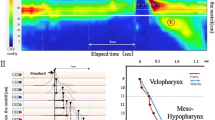Abstract
A modified bolus technique for the measurement of “closing volume” is described; it involves the use of133Xe as tracer, a pneumotachograph in an open system for control of flow and volume, and a gamma camera for direct registration of the radioactivity over the lung. The results obtained in a group of 11 normal subjects are in good agreement with the predicted values obtained with the original133Xe bolus technique. The disadvantages of the method described are the expensive apparatus and the rather large amounts of radioactivity needed. The advantages are: easy handling of the open system, no dead-space effect compared to methods in which the tracer gas is recorded at the mouth, and regional location of airway closure.
Zusammenfassung
Es wird eine modifizierte Bolustechnik zur Bestimmung des Verschlußvolumens (“closing volume”) beschrieben, bei der133Xenon als Tracergas, ein Pneumotachograph in einem offenen System zur Registrierung von Atemstromstärke und Atemvolumen und eine Scintillationskamera mit einem Digitalrechner zur direkten Registrierung und Auswertung der radioaktiven Impulse über der Lunge zur Anwendung kommen. Unsere Ergebnisse bei einer Gruppe von 11 Normalpersonen stimmen gut mit den in der Literatur beschriebenen Ergebnissen der Original-133Xenon-Bolus-Methode überein. Die Nachteile des Systems liegen in dem apparativen Aufwand und den etwas höheren Mengen radioaktiven Gases, die benötigt werden; die Vorteile lassen sich wie folgt zusammenfassen:
Einfache Handhabung des offenen Systems gegenüber einem Spirometersystem, Wegfall des anatomischen und apparativen Totraumeffektes gegenüber Methoden, bei denen die Inertgasbestimmung am Mund erfolgt, und die Möglichkeit, das Phänomen des Atemwegsverschlusses regional zu orten.
Similar content being viewed by others
Literatur
Laenaec, R. T. H.: A treatise on mediat e auscultation and on diseases of the lungs and heart. Translated by a member of the College of Physicans. Ed.: Th. Herbert. London: Baillière, p. 141, 1846
Macklem, P. T.: Obstruction in small airways — a challange to medicine. Amer. J. Med.52, 721 (1972)
Wollcock, A. J., Vincent, N. J., Macklem, P. T.: Frequency dependence of compliance as a test for obstruction in the small airways. J. clin. Invest.48, 1097 (1969)
Matthys, H.: Lungenfunktionsdiagnostik mittels Ganzkörperplethysmographie. Stuttgart-New York: Schattauer, 1973
Konietzko, N. H., Schlehe, K. H., Rühle, W. E., Bitter, A. F., Matthys, H.: Regional ventilation of the lungs as measured with the scintillation camera and a data processing system. J. Nucl. Biol. Med.16, 125 (1972)
Dollfuss, R. E., Milic-Emili, J., Bates, D. V.: Regional ventilation of the lungs, studied with boluses of133Xenon. Resp. Physiol.2, 234 (1967)
Amrein, R., Keller, R., Joos, H., Herzog, H.: Neue Normalwerte für die Lungenfunktionsprüfung mit der Ganzkörperplethysmographie. Dtsch. med. Wschr.94, 1785 (1969)
Leblanc, P., Ruff, F., Milic-Emili, J.: Effects of age and body position on “airway closure” in man. J. appl. Physiol.28, 448 (1970)
Author information
Authors and Affiliations
Additional information
Mit Unterstützung der Deutschen Forschungsgemeinschaft (Ma 466/3 und Ad 20/5).
Rights and permissions
About this article
Cite this article
Konietzko, N., Schlehe, K.H., Gerke, E. et al. Der Nachweis des Verschlusses kleiner Luftwege mit Hilfe einer modifizierten133Xenon-Bolustechnik. Pneumonologie 149, 113–117 (1973). https://doi.org/10.1007/BF02151746
Issue Date:
DOI: https://doi.org/10.1007/BF02151746




